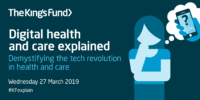Livongo gets behaviorally stronger with myStrength. Extending from their base in diabetes and chronic disease management into behavioral health, Livongo made a logical extension with early-stage behavioral health company myStrength. A large percentage of those with chronic conditions are also struggling with a behavioral health issue–Livongo cites 20 percent but in this Editor’s opinion, the estimate is low. Both Livongo and myStrength have been very successful in the payment game, with both companies achieving payment and reimbursement by employers, insurers, health systems, and state/Federal payers. The other factor is that employers and payers want single, integrated platforms for wellness and disease management. Livongo last year bought Retrofit for its weight management program. Competitor Omada Health recently acquired the behavioral health technology of defunct Lantern. MedCityNews, Fortune, Livongo release

Apple Watch wastes no time in partnering with insurers. Or vice versa! Confirming that Apple Watch’s growth strategy hinges heavily on health via its new features are fresh agreements with Aetna/CVS Health and a rumored reach into three Medicare Advantage plans. The Aetna partnership is with an app called Attain, which blends Apple Watch activity tracking data with users’ health history to create personalized programs. The program is limited to about 250,000 slots plus additional slots for employer plans, and will debut this spring. Late last year, United HealthCare announced Apple Watches would be added to existing wellness program called Motion and their Rally platform. Both Aetna and United have tiered payment programs for the watches, with United adding a HSA reward. For Medicare Advantage plans, Apple is rumored that they will subsidize the watch for use as a health tracker and coach. FierceMobileHealthcare 30 Jan (Aetna), 14 Nov 18 (UHC), and 29 Jan (Medicare Advantage).
Lively adds telehealth to hearing assistance. Lively’s mobile-connected, direct to consumer hearing aids are adding more telehealth features such as remote tuning, virtual video consults with an audiologist, and an online hearing assessment/uploading audiogram for assessment. The NYC-based company also announced closing on a $16 million seed/Series A fundraising round led by Declaration Capital with participation from Tiger Management. There are an estimated 35 million Americans with hearing loss in a $10bn annual market. Hearing aids are rapidly adding digital and DTC features–others in the field are Eargo and ReSound. Lively release, AlleyWatch, Mobihealthnews. (Lively is not to be confused with Lively!, acquired by GreatCall two years ago)












Most Recent Comments